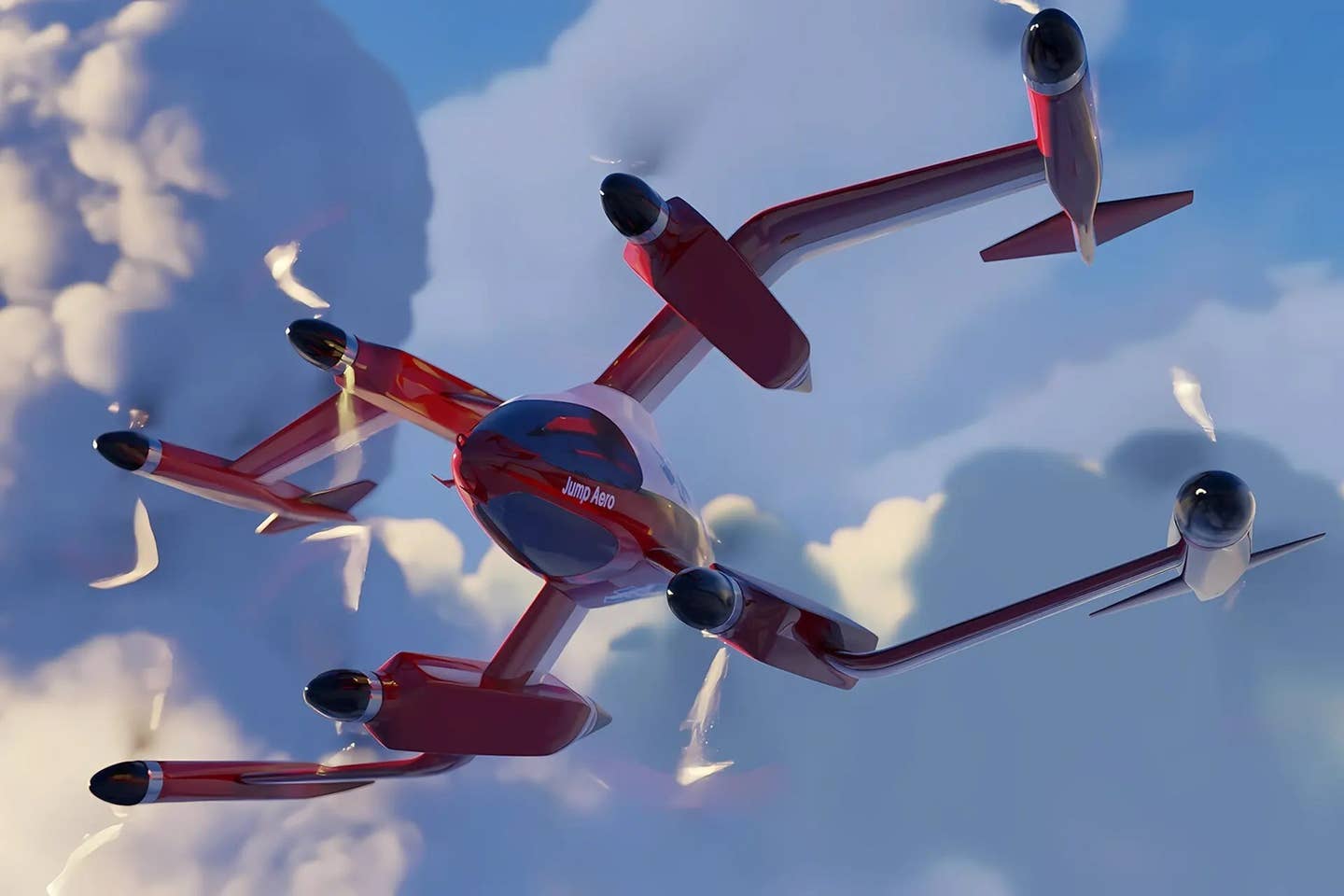Startup Jump Aero Reveals Air Force-Backed Emergency eVTOL Design
Most eVTOL manufacturers are looking to provide air taxi services, but Jump Aero wants to help medical professionals cut down on response times.

Here’s what Jump Aero’s JA1 Pulse eVTOL may look like in forward flight. [Courtesy: Jump Aero]
Days before the 22nd anniversary of the September 11 tragedy, a California startup unveiled a design it hopes represents the next generation of emergency response vehicles—one that could arrive on the scene faster than an ambulance.
Petaluma, California-based Jump Aero last week revealed its model for an electric vertical takeoff and landing (eVTOL) first response aircraft the startup has been developing since 2019. Jump says its JA1 “Pulse” will be able to fly emergency responders and equipment anywhere within a 31 sm (27 nm) radius in less than eight minutes. The goal is to cut response times in half.
Pulse is designed to help medical professionals arrive on the scene of rural emergencies with lifesaving equipment as fast as possible. It has a dash speed of 250 knots and a payload of 330 pounds, enough to carry a pilot plus emergency supplies.
Simultaneously, Jump announced a $1.8 million tactical funding increase (TACFI), adding to the $3.6 million in contract value the company previously won through the U.S. Air Force’s AFWERX division. AFWERX is the innovation arm of the Air Force and will partially fund Jump’s first full-scale, proof-of-concept prototype.
“Jump Aero's aircraft concept and development strategy focusing on rapid emergency response has potential for defense-related use-cases and is complementary to the other eVTOL programs that the U.S. Air Force's Agility Prime program has engaged with to date,” said Lieutenant Colonel John Tekell, program lead for AFWERX’s Agility Prime division, which is dedicated to vertical lift technologies. “We look forward to working with Jump Aero to help mature their dual-use technology.”
In addition, Jump revealed that Denmark-based Falck Ambulance Services—which provides some 8 million emergency response and healthcare services every year—purchased an option to order a single Pulse aircraft, becoming the firm’s first customer. It serves clients in 15 countries.
“Falck is excited to partner with Jump Aero to help us revolutionize the future of emergency services,” said Jakob Riis, CEO of Falck. “By enabling professional help to reach hard-to-access locations in a timely manner, Jump Aero will help Falck to deliver improved services to our customers.”
The Specs
According to Carl Dietrich—the cofounder of flying car manufacturer Terrafugia, who launched Jump alongside partner Anna, director of regulatory affairs for XWing and co-founder of the Community Air Mobility Initiative, in 2019—Pulse will not replace helicopters.
Rather, it will complement them by expanding the locations first responders can land, such as in front of a home on a two-way residential street. eVTOLs are also easier to “switch on” and “switch off” compared to piston- or turbine-engine rotorcraft, which need a bit more time to get flying. Those few minutes can feel like hours in emergency situations.
Since it can’t carry patients, Pulse won’t be replacing ambulances either. Instead, in cases where extra support is needed, dispatchers might send both an ambulance and a Pulse, the latter of which would theoretically arrive first to begin treatment.
The first responder niche eliminates some barriers to entry faced by eVTOL air taxi firms such as Joby Aviation, Archer Aviation, and Boeing-owned Wisk Aero, which are subject to greater FAA scrutiny because they plan to carry passengers. It also allows Jump to avoid butting heads with the industry’s well-funded titans.
“The use of eVTOLs—where someone’s life is at stake—is much more likely to be accepted by society at large than air taxis,” Dietrich told FLYING in 2020. “The chance to develop something that might save someone’s life someday—that is a really compelling story.”
To that point, Pulse can be deployed in less than 60 seconds and travel anywhere within about a 30-mile radius in just minutes. That’s comparable to an ambulance in most situations, but Pulse has the added advantage of being able to avoid traffic on the road.
The aircraft—a tail-sitter biplane that stands nose up on the runway—runs on eight independent batteries powering eight motors, four each on its two sets of fixed wings. In forward flight, it cruises on the wings. At takeoff, the pilot stands upright before transitioning to a prone position—à la Superman—when Pulse tilts forward.
A large belly window provides an unobstructed view of the ground below to enable steep approaches, allowing Pulse to land on 10-degree slopes (which covers most roads and driveways). Simplified flight controls with full envelope protection, a ballistic airframe parachute, and an adaptive flight controller with run-time-assurance architecture bolster its safety. The design also features a high lift-to-drag ratio, a low frontal area, and can continue hovering at about 9,500 feet density altitude with a failed propulsor.
Crucially, Pulse is compact enough to fit in a flatbed trailer without being disassembled, allowing emergency services to transport and deploy it where needed. It also lacks complex systems such as articulating motors and retractable landing gear, making it easy to maintain.
So far, Jump has yet to announce a hard entry-into-service deadline. Some eVTOL manufactures, including Joby and Archer, hope to launch commercial air taxi services as soon as 2025. Others, such as Wisk, are looking further out, eyeing the range of 2028 to 2030. Jump’s first deliveries will likely also take place sometime in the next five years—if all goes according to plan.
Like this story? We think you'll also like the Future of FLYING newsletter sent every Thursday afternoon. Sign up now.

Sign-up for newsletters & special offers!
Get the latest FLYING stories & special offers delivered directly to your inbox






